Finance and Funding Analysis: Travel and Tourism Sector
VerifiedAdded on 2020/11/12
|11
|3020
|275
Report
AI Summary
This report provides a comprehensive analysis of finance and funding within the travel and tourism sector, examining key financial concepts and their practical applications. It begins by exploring the significance of cost and volume analysis in financial management, including break-even analysis and the calculation of customer volume needed to achieve profit targets. The report then delves into various pricing methods used in the travel sector, such as skimming, per-person, penetration, and cost-plus pricing, and analyzes the factors influencing profits, including climate, political stability, and tourism seasons. Furthermore, it discusses different types of management accounting information that aid in financial decision-making, such as financial statements, variance analysis, budgets, forecasting, and performance evaluation, and illustrates their use as financial decision-making tools. The report includes a case study on the British Museum, analyzing its profitability, liquidity, and efficiency ratios, and providing interpretations of the financial performance. Finally, the report explores sources of funding available to organizations like the Local Wildlife Trust, offering a holistic overview of financial management within the tourism industry.
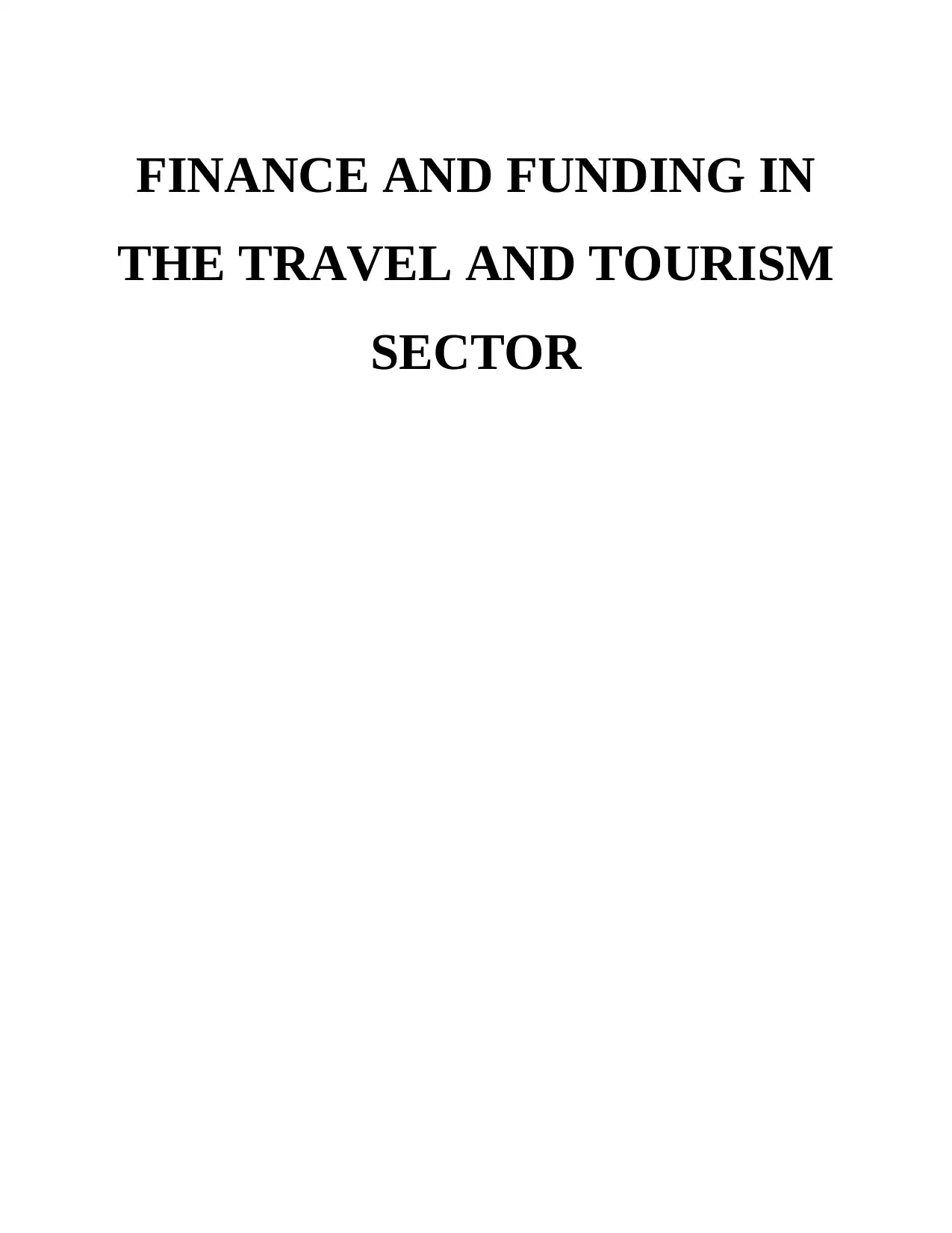
FINANCE AND FUNDING IN
THE TRAVEL AND TOURISM
SECTOR
THE TRAVEL AND TOURISM
SECTOR
Paraphrase This Document
Need a fresh take? Get an instant paraphrase of this document with our AI Paraphraser
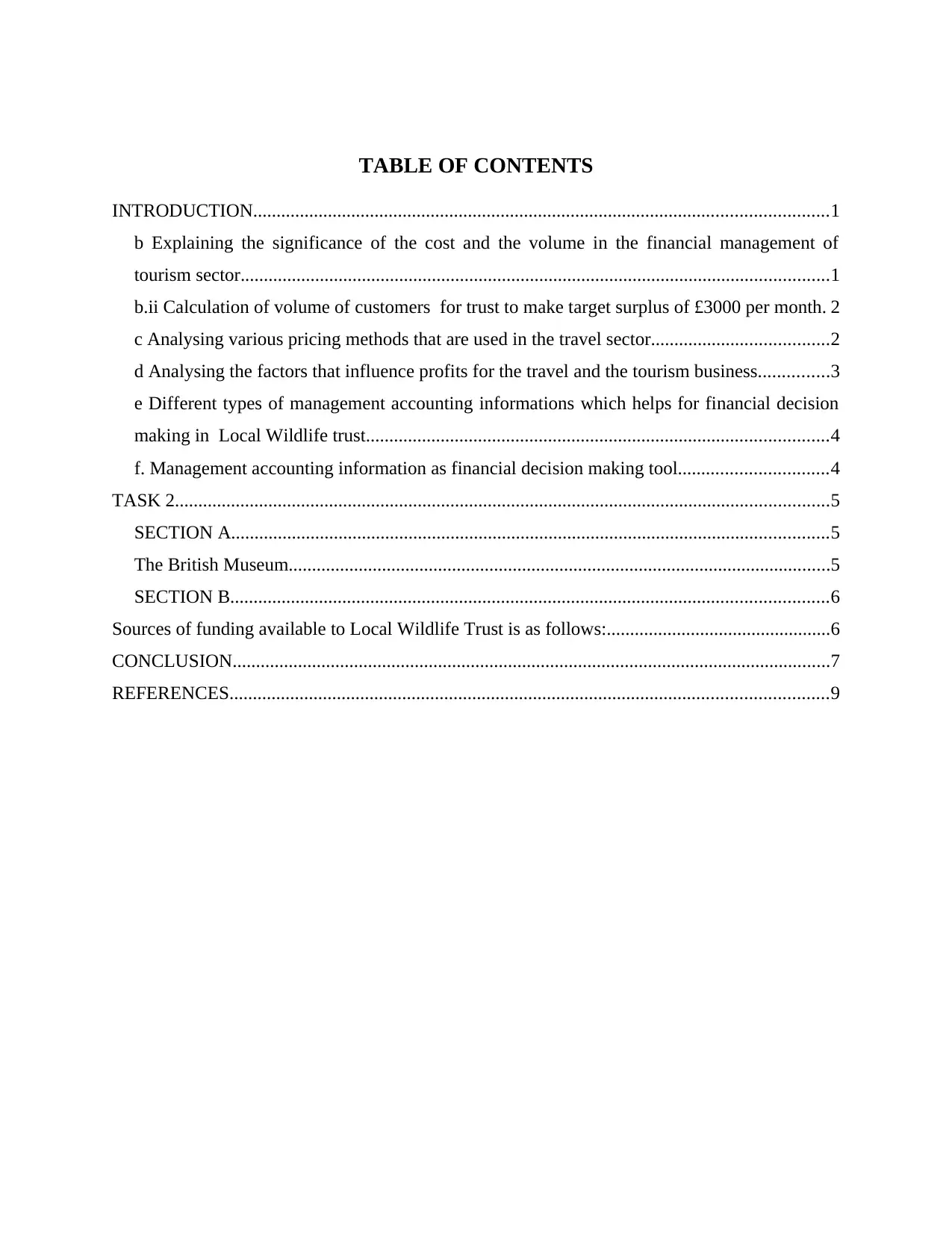
TABLE OF CONTENTS
INTRODUCTION...........................................................................................................................1
b Explaining the significance of the cost and the volume in the financial management of
tourism sector..............................................................................................................................1
b.ii Calculation of volume of customers for trust to make target surplus of £3000 per month. 2
c Analysing various pricing methods that are used in the travel sector......................................2
d Analysing the factors that influence profits for the travel and the tourism business...............3
e Different types of management accounting informations which helps for financial decision
making in Local Wildlife trust...................................................................................................4
f. Management accounting information as financial decision making tool................................4
TASK 2............................................................................................................................................5
SECTION A................................................................................................................................5
The British Museum....................................................................................................................5
SECTION B................................................................................................................................6
Sources of funding available to Local Wildlife Trust is as follows:................................................6
CONCLUSION................................................................................................................................7
REFERENCES................................................................................................................................9
INTRODUCTION...........................................................................................................................1
b Explaining the significance of the cost and the volume in the financial management of
tourism sector..............................................................................................................................1
b.ii Calculation of volume of customers for trust to make target surplus of £3000 per month. 2
c Analysing various pricing methods that are used in the travel sector......................................2
d Analysing the factors that influence profits for the travel and the tourism business...............3
e Different types of management accounting informations which helps for financial decision
making in Local Wildlife trust...................................................................................................4
f. Management accounting information as financial decision making tool................................4
TASK 2............................................................................................................................................5
SECTION A................................................................................................................................5
The British Museum....................................................................................................................5
SECTION B................................................................................................................................6
Sources of funding available to Local Wildlife Trust is as follows:................................................6
CONCLUSION................................................................................................................................7
REFERENCES................................................................................................................................9
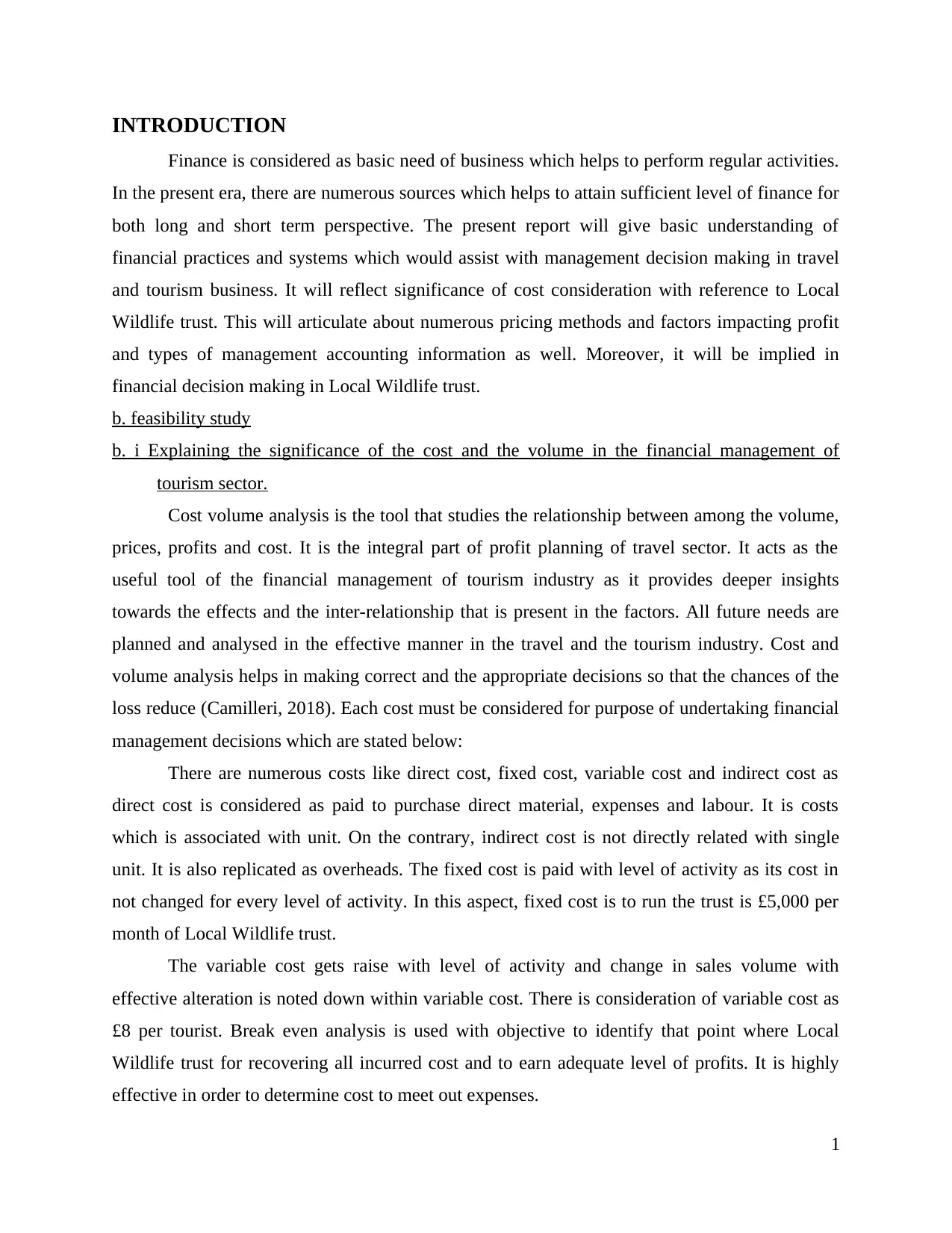
INTRODUCTION
Finance is considered as basic need of business which helps to perform regular activities.
In the present era, there are numerous sources which helps to attain sufficient level of finance for
both long and short term perspective. The present report will give basic understanding of
financial practices and systems which would assist with management decision making in travel
and tourism business. It will reflect significance of cost consideration with reference to Local
Wildlife trust. This will articulate about numerous pricing methods and factors impacting profit
and types of management accounting information as well. Moreover, it will be implied in
financial decision making in Local Wildlife trust.
b. feasibility study
b. i Explaining the significance of the cost and the volume in the financial management of
tourism sector.
Cost volume analysis is the tool that studies the relationship between among the volume,
prices, profits and cost. It is the integral part of profit planning of travel sector. It acts as the
useful tool of the financial management of tourism industry as it provides deeper insights
towards the effects and the inter-relationship that is present in the factors. All future needs are
planned and analysed in the effective manner in the travel and the tourism industry. Cost and
volume analysis helps in making correct and the appropriate decisions so that the chances of the
loss reduce (Camilleri, 2018). Each cost must be considered for purpose of undertaking financial
management decisions which are stated below:
There are numerous costs like direct cost, fixed cost, variable cost and indirect cost as
direct cost is considered as paid to purchase direct material, expenses and labour. It is costs
which is associated with unit. On the contrary, indirect cost is not directly related with single
unit. It is also replicated as overheads. The fixed cost is paid with level of activity as its cost in
not changed for every level of activity. In this aspect, fixed cost is to run the trust is £5,000 per
month of Local Wildlife trust.
The variable cost gets raise with level of activity and change in sales volume with
effective alteration is noted down within variable cost. There is consideration of variable cost as
£8 per tourist. Break even analysis is used with objective to identify that point where Local
Wildlife trust for recovering all incurred cost and to earn adequate level of profits. It is highly
effective in order to determine cost to meet out expenses.
1
Finance is considered as basic need of business which helps to perform regular activities.
In the present era, there are numerous sources which helps to attain sufficient level of finance for
both long and short term perspective. The present report will give basic understanding of
financial practices and systems which would assist with management decision making in travel
and tourism business. It will reflect significance of cost consideration with reference to Local
Wildlife trust. This will articulate about numerous pricing methods and factors impacting profit
and types of management accounting information as well. Moreover, it will be implied in
financial decision making in Local Wildlife trust.
b. feasibility study
b. i Explaining the significance of the cost and the volume in the financial management of
tourism sector.
Cost volume analysis is the tool that studies the relationship between among the volume,
prices, profits and cost. It is the integral part of profit planning of travel sector. It acts as the
useful tool of the financial management of tourism industry as it provides deeper insights
towards the effects and the inter-relationship that is present in the factors. All future needs are
planned and analysed in the effective manner in the travel and the tourism industry. Cost and
volume analysis helps in making correct and the appropriate decisions so that the chances of the
loss reduce (Camilleri, 2018). Each cost must be considered for purpose of undertaking financial
management decisions which are stated below:
There are numerous costs like direct cost, fixed cost, variable cost and indirect cost as
direct cost is considered as paid to purchase direct material, expenses and labour. It is costs
which is associated with unit. On the contrary, indirect cost is not directly related with single
unit. It is also replicated as overheads. The fixed cost is paid with level of activity as its cost in
not changed for every level of activity. In this aspect, fixed cost is to run the trust is £5,000 per
month of Local Wildlife trust.
The variable cost gets raise with level of activity and change in sales volume with
effective alteration is noted down within variable cost. There is consideration of variable cost as
£8 per tourist. Break even analysis is used with objective to identify that point where Local
Wildlife trust for recovering all incurred cost and to earn adequate level of profits. It is highly
effective in order to determine cost to meet out expenses.
1
⊘ This is a preview!⊘
Do you want full access?
Subscribe today to unlock all pages.

Trusted by 1+ million students worldwide
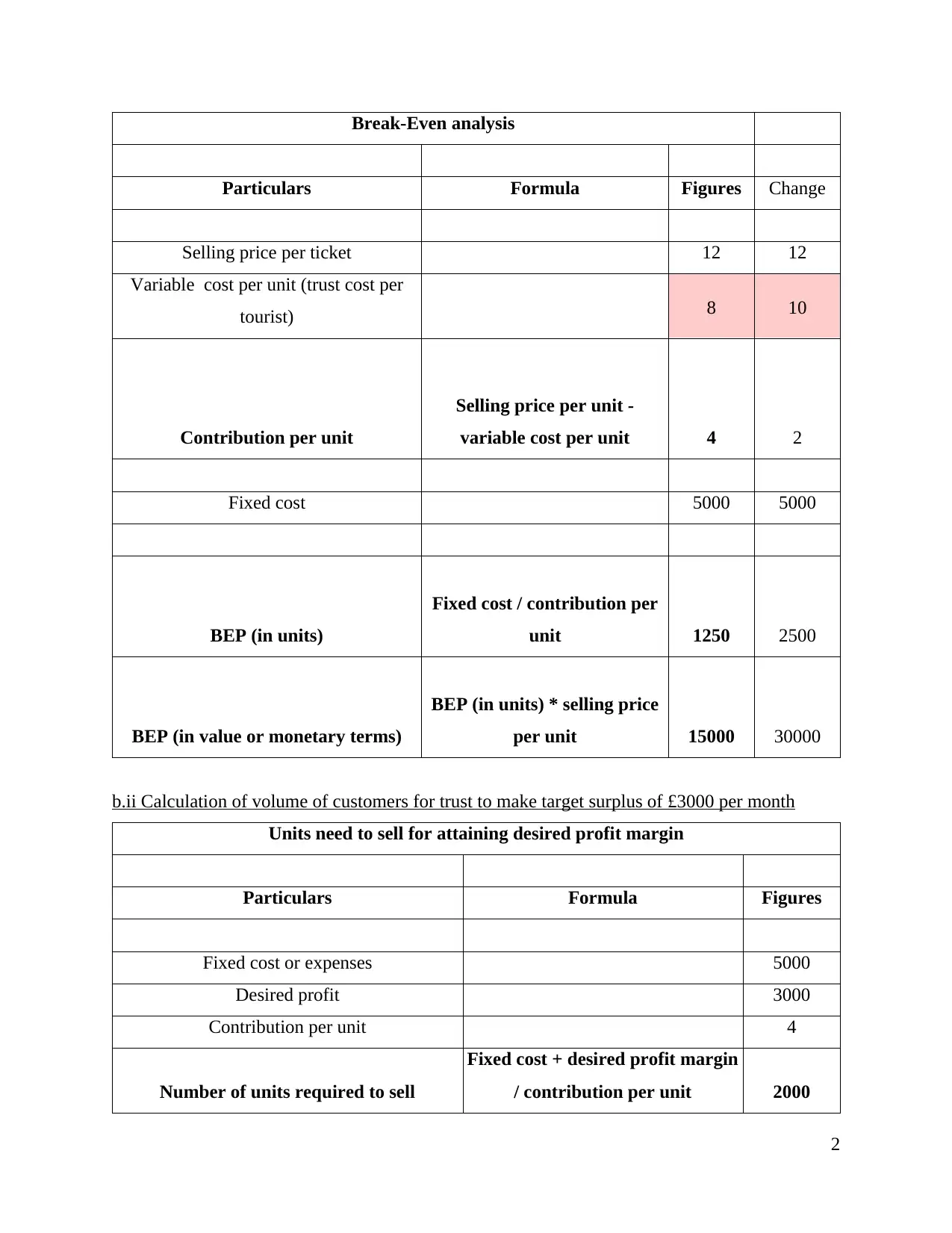
Break-Even analysis
Particulars Formula Figures Change
Selling price per ticket 12 12
Variable cost per unit (trust cost per
tourist) 8 10
Contribution per unit
Selling price per unit -
variable cost per unit 4 2
Fixed cost 5000 5000
BEP (in units)
Fixed cost / contribution per
unit 1250 2500
BEP (in value or monetary terms)
BEP (in units) * selling price
per unit 15000 30000
b.ii Calculation of volume of customers for trust to make target surplus of £3000 per month
Units need to sell for attaining desired profit margin
Particulars Formula Figures
Fixed cost or expenses 5000
Desired profit 3000
Contribution per unit 4
Number of units required to sell
Fixed cost + desired profit margin
/ contribution per unit 2000
2
Particulars Formula Figures Change
Selling price per ticket 12 12
Variable cost per unit (trust cost per
tourist) 8 10
Contribution per unit
Selling price per unit -
variable cost per unit 4 2
Fixed cost 5000 5000
BEP (in units)
Fixed cost / contribution per
unit 1250 2500
BEP (in value or monetary terms)
BEP (in units) * selling price
per unit 15000 30000
b.ii Calculation of volume of customers for trust to make target surplus of £3000 per month
Units need to sell for attaining desired profit margin
Particulars Formula Figures
Fixed cost or expenses 5000
Desired profit 3000
Contribution per unit 4
Number of units required to sell
Fixed cost + desired profit margin
/ contribution per unit 2000
2
Paraphrase This Document
Need a fresh take? Get an instant paraphrase of this document with our AI Paraphraser
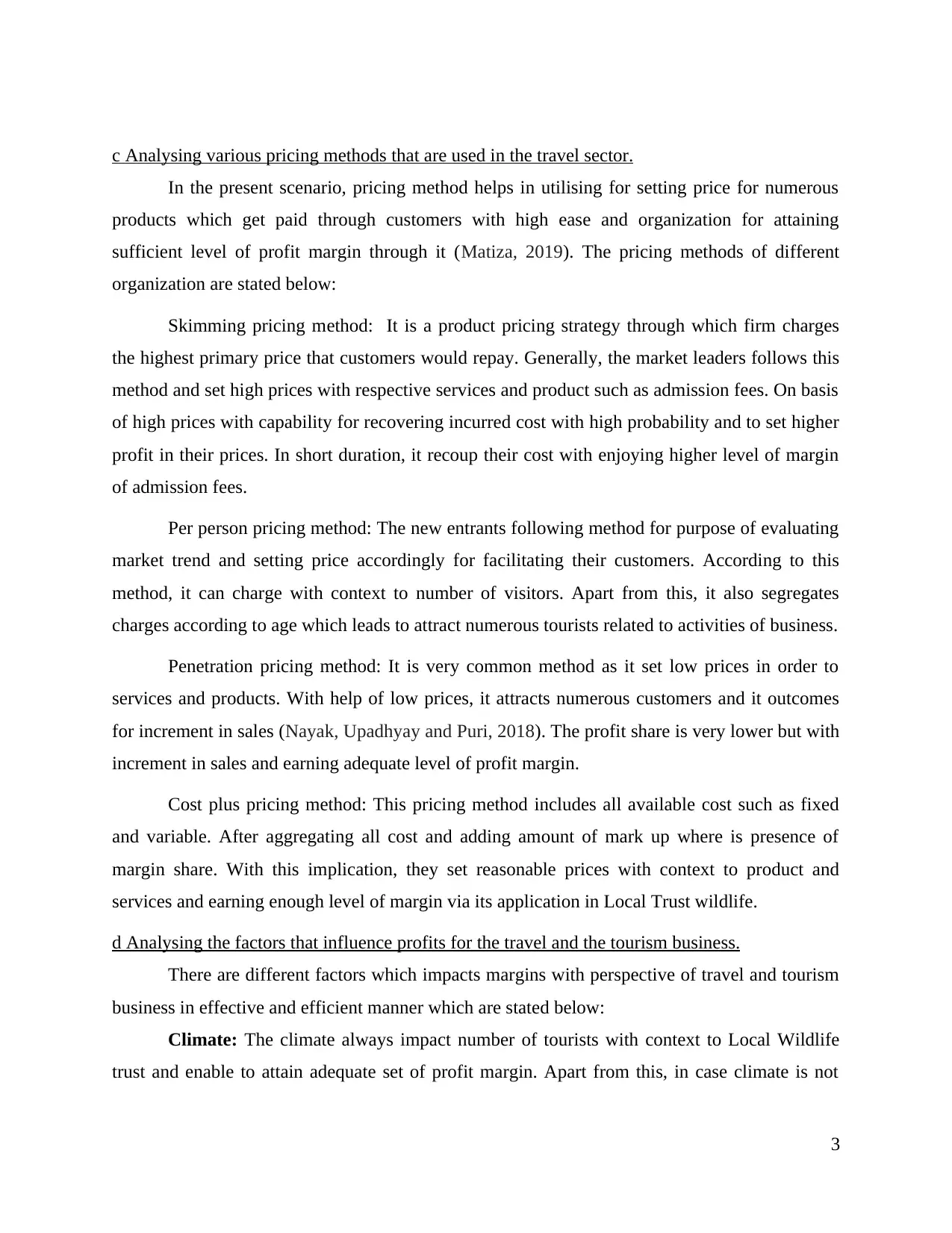
c Analysing various pricing methods that are used in the travel sector.
In the present scenario, pricing method helps in utilising for setting price for numerous
products which get paid through customers with high ease and organization for attaining
sufficient level of profit margin through it (Matiza, 2019). The pricing methods of different
organization are stated below:
Skimming pricing method: It is a product pricing strategy through which firm charges
the highest primary price that customers would repay. Generally, the market leaders follows this
method and set high prices with respective services and product such as admission fees. On basis
of high prices with capability for recovering incurred cost with high probability and to set higher
profit in their prices. In short duration, it recoup their cost with enjoying higher level of margin
of admission fees.
Per person pricing method: The new entrants following method for purpose of evaluating
market trend and setting price accordingly for facilitating their customers. According to this
method, it can charge with context to number of visitors. Apart from this, it also segregates
charges according to age which leads to attract numerous tourists related to activities of business.
Penetration pricing method: It is very common method as it set low prices in order to
services and products. With help of low prices, it attracts numerous customers and it outcomes
for increment in sales (Nayak, Upadhyay and Puri, 2018). The profit share is very lower but with
increment in sales and earning adequate level of profit margin.
Cost plus pricing method: This pricing method includes all available cost such as fixed
and variable. After aggregating all cost and adding amount of mark up where is presence of
margin share. With this implication, they set reasonable prices with context to product and
services and earning enough level of margin via its application in Local Trust wildlife.
d Analysing the factors that influence profits for the travel and the tourism business.
There are different factors which impacts margins with perspective of travel and tourism
business in effective and efficient manner which are stated below:
Climate: The climate always impact number of tourists with context to Local Wildlife
trust and enable to attain adequate set of profit margin. Apart from this, in case climate is not
3
In the present scenario, pricing method helps in utilising for setting price for numerous
products which get paid through customers with high ease and organization for attaining
sufficient level of profit margin through it (Matiza, 2019). The pricing methods of different
organization are stated below:
Skimming pricing method: It is a product pricing strategy through which firm charges
the highest primary price that customers would repay. Generally, the market leaders follows this
method and set high prices with respective services and product such as admission fees. On basis
of high prices with capability for recovering incurred cost with high probability and to set higher
profit in their prices. In short duration, it recoup their cost with enjoying higher level of margin
of admission fees.
Per person pricing method: The new entrants following method for purpose of evaluating
market trend and setting price accordingly for facilitating their customers. According to this
method, it can charge with context to number of visitors. Apart from this, it also segregates
charges according to age which leads to attract numerous tourists related to activities of business.
Penetration pricing method: It is very common method as it set low prices in order to
services and products. With help of low prices, it attracts numerous customers and it outcomes
for increment in sales (Nayak, Upadhyay and Puri, 2018). The profit share is very lower but with
increment in sales and earning adequate level of profit margin.
Cost plus pricing method: This pricing method includes all available cost such as fixed
and variable. After aggregating all cost and adding amount of mark up where is presence of
margin share. With this implication, they set reasonable prices with context to product and
services and earning enough level of margin via its application in Local Trust wildlife.
d Analysing the factors that influence profits for the travel and the tourism business.
There are different factors which impacts margins with perspective of travel and tourism
business in effective and efficient manner which are stated below:
Climate: The climate always impact number of tourists with context to Local Wildlife
trust and enable to attain adequate set of profit margin. Apart from this, in case climate is not
3

pleasant then it will decrease number of tourists and gives adverse impact on profit earning
capacity of Local Wildlife trust.
Political stability: Political stability of nation gives direct impact on Local Wildlife trust
with effect they charge sufficient charges for respective services and earning profit's adequate
with high effect. On the contrary, if political party is not stable they could attain fix rate of taxes
due to which could not finalise prices that outcome into failing attractive tourists with them.
Season of tourism: With the peak season of tourism then Local Wildlife trust earn high
level of margin from business activities and easily attain expenditure along with other
requirements. However, in off tourism season they does not enable to attain adequate revenues
with context to attain expenditure of fixed nature (Dwyer, 2018). Thus, tourism season gives
impact profit earning capacity of the Local Wildlife trust.
e Different types of management accounting information which helps for financial decision
making in Local Wildlife trust
Management accounting information lays special emphasis on internal mangers along
with decision makers. It is intended to give financial data with context to operation of manager in
an effort to undertake sound business decisions. It is adequate information and helps
management for making effective decisions and this collates data through different department
and availability to respective users. The Local Wildlife Trust could use the below stated
management accounting information for decision making:
Financial statements: The management utilises information with context to analyse
financial status so it gets to relate with reference to financial efficiency. Hence, using
this company can do trend as well as ratio analysis and thereby would become able to
make suitable modifications in the current strategic framework.
Variance analysis: It leads to determine the loop holes within process so this will be
directly associated to improvement level. Such tool helps in finding reasons behind
deviations and thereby helps in taking corrective measure within the suitable time frame.
Budgets: This render the budgeted result which is useful for comparing itself with actual
performance. This helps in making appropriate financial forecast for the upcoming
period.
Forecasting: Generally, information is gathered and utilised with objective to predict on
basis of future preferences and needs.
4
capacity of Local Wildlife trust.
Political stability: Political stability of nation gives direct impact on Local Wildlife trust
with effect they charge sufficient charges for respective services and earning profit's adequate
with high effect. On the contrary, if political party is not stable they could attain fix rate of taxes
due to which could not finalise prices that outcome into failing attractive tourists with them.
Season of tourism: With the peak season of tourism then Local Wildlife trust earn high
level of margin from business activities and easily attain expenditure along with other
requirements. However, in off tourism season they does not enable to attain adequate revenues
with context to attain expenditure of fixed nature (Dwyer, 2018). Thus, tourism season gives
impact profit earning capacity of the Local Wildlife trust.
e Different types of management accounting information which helps for financial decision
making in Local Wildlife trust
Management accounting information lays special emphasis on internal mangers along
with decision makers. It is intended to give financial data with context to operation of manager in
an effort to undertake sound business decisions. It is adequate information and helps
management for making effective decisions and this collates data through different department
and availability to respective users. The Local Wildlife Trust could use the below stated
management accounting information for decision making:
Financial statements: The management utilises information with context to analyse
financial status so it gets to relate with reference to financial efficiency. Hence, using
this company can do trend as well as ratio analysis and thereby would become able to
make suitable modifications in the current strategic framework.
Variance analysis: It leads to determine the loop holes within process so this will be
directly associated to improvement level. Such tool helps in finding reasons behind
deviations and thereby helps in taking corrective measure within the suitable time frame.
Budgets: This render the budgeted result which is useful for comparing itself with actual
performance. This helps in making appropriate financial forecast for the upcoming
period.
Forecasting: Generally, information is gathered and utilised with objective to predict on
basis of future preferences and needs.
4
⊘ This is a preview!⊘
Do you want full access?
Subscribe today to unlock all pages.

Trusted by 1+ million students worldwide

Performance evaluation: Management undertakes all collected information for evaluating
performance and to identify these loop holes along with enhancing performance.
f. Management accounting information as financial decision making tool
Management accounting information is used as financial decision making tool as
financial analysis helps in taking decision and not to invest in the organization's share capital.
The financial statement lays important role in giving useful information for investment decision
making purpose (Meseko, Obieje and Karpenko, 2018). It helps to undertakes decisions with
perspective of taxation decisions. Moreover, variance analysis is very significant which leads to
assist by managing budgets through controlling budgeted vs actual costs. Variances among
planned and actual cost will directly lead to adjust objectives, goals and strategies of business.
This replicates difference and management accountants could observe that how business could
build positive variances or avoiding negative ones in future.
Consequently, budgets are financial plans for the future and helps business to trace that
where cost is charged and from where revenue is generated. They are very important to help and
coordinate different parts and business activities. Thus, performance evaluation helps in gaining
information that how business is doing and related to objectives of business which enables for
profit and obtaining return on investment and collecting debt on quick aspect.
TASK 2
(SECTION A)
Interpretation of The British Museum
Profitability ratio analysis
Particulars Formula 2017 2018
Net profit 29,551 2,128
Sales revenue 117,730 104,425
Average total assets 905882 932308
NP ratio Net profit / sales * 100 25% 2%
Return on assets Net income / average total assets 3.26% 0.23%
(Sources: ANNUAL REPORT OF THE BRITISH MUSEUM, 2018)
Liquidity ratio analysis
5
performance and to identify these loop holes along with enhancing performance.
f. Management accounting information as financial decision making tool
Management accounting information is used as financial decision making tool as
financial analysis helps in taking decision and not to invest in the organization's share capital.
The financial statement lays important role in giving useful information for investment decision
making purpose (Meseko, Obieje and Karpenko, 2018). It helps to undertakes decisions with
perspective of taxation decisions. Moreover, variance analysis is very significant which leads to
assist by managing budgets through controlling budgeted vs actual costs. Variances among
planned and actual cost will directly lead to adjust objectives, goals and strategies of business.
This replicates difference and management accountants could observe that how business could
build positive variances or avoiding negative ones in future.
Consequently, budgets are financial plans for the future and helps business to trace that
where cost is charged and from where revenue is generated. They are very important to help and
coordinate different parts and business activities. Thus, performance evaluation helps in gaining
information that how business is doing and related to objectives of business which enables for
profit and obtaining return on investment and collecting debt on quick aspect.
TASK 2
(SECTION A)
Interpretation of The British Museum
Profitability ratio analysis
Particulars Formula 2017 2018
Net profit 29,551 2,128
Sales revenue 117,730 104,425
Average total assets 905882 932308
NP ratio Net profit / sales * 100 25% 2%
Return on assets Net income / average total assets 3.26% 0.23%
(Sources: ANNUAL REPORT OF THE BRITISH MUSEUM, 2018)
Liquidity ratio analysis
5
Paraphrase This Document
Need a fresh take? Get an instant paraphrase of this document with our AI Paraphraser
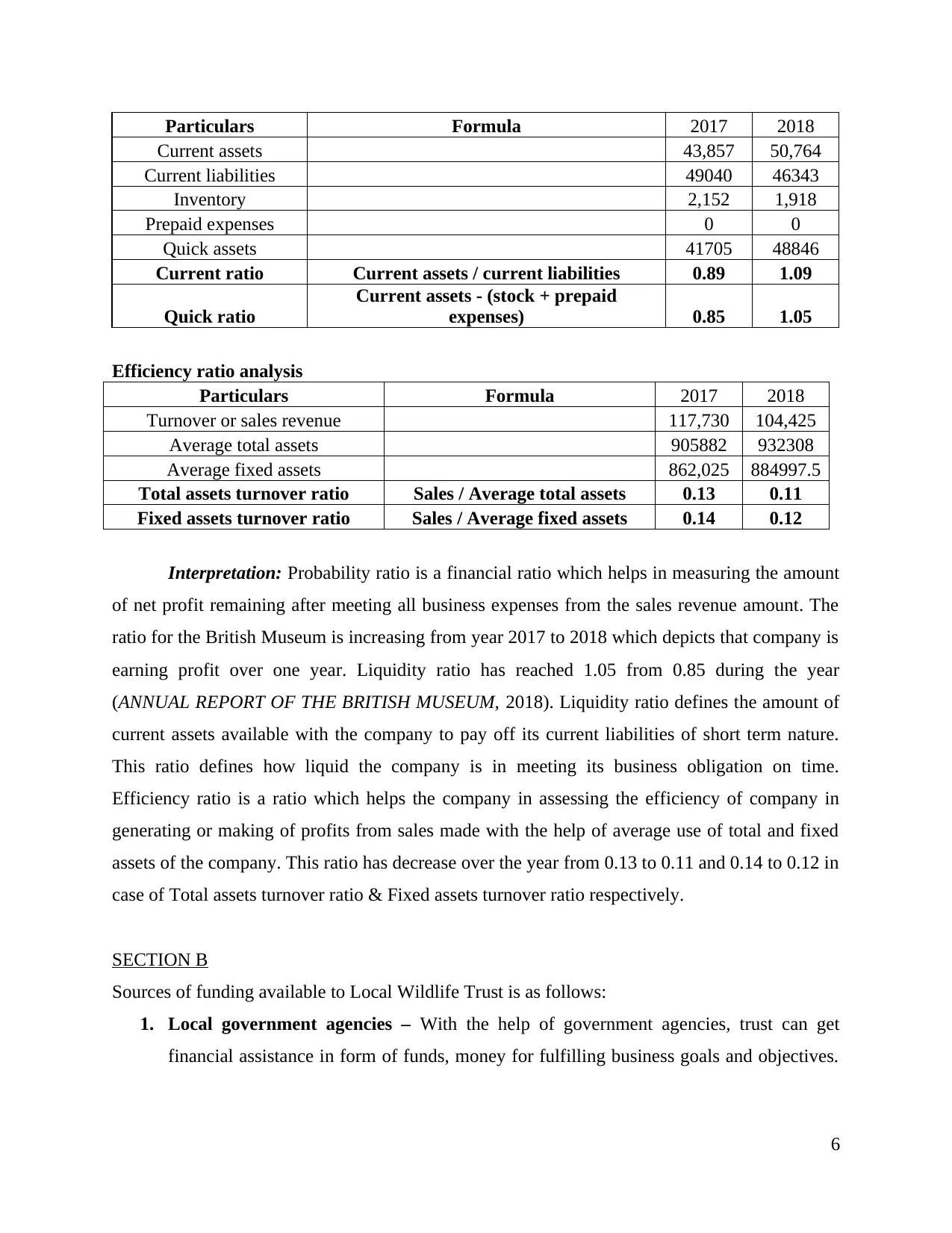
Particulars Formula 2017 2018
Current assets 43,857 50,764
Current liabilities 49040 46343
Inventory 2,152 1,918
Prepaid expenses 0 0
Quick assets 41705 48846
Current ratio Current assets / current liabilities 0.89 1.09
Quick ratio
Current assets - (stock + prepaid
expenses) 0.85 1.05
Efficiency ratio analysis
Particulars Formula 2017 2018
Turnover or sales revenue 117,730 104,425
Average total assets 905882 932308
Average fixed assets 862,025 884997.5
Total assets turnover ratio Sales / Average total assets 0.13 0.11
Fixed assets turnover ratio Sales / Average fixed assets 0.14 0.12
Interpretation: Probability ratio is a financial ratio which helps in measuring the amount
of net profit remaining after meeting all business expenses from the sales revenue amount. The
ratio for the British Museum is increasing from year 2017 to 2018 which depicts that company is
earning profit over one year. Liquidity ratio has reached 1.05 from 0.85 during the year
(ANNUAL REPORT OF THE BRITISH MUSEUM, 2018). Liquidity ratio defines the amount of
current assets available with the company to pay off its current liabilities of short term nature.
This ratio defines how liquid the company is in meeting its business obligation on time.
Efficiency ratio is a ratio which helps the company in assessing the efficiency of company in
generating or making of profits from sales made with the help of average use of total and fixed
assets of the company. This ratio has decrease over the year from 0.13 to 0.11 and 0.14 to 0.12 in
case of Total assets turnover ratio & Fixed assets turnover ratio respectively.
SECTION B
Sources of funding available to Local Wildlife Trust is as follows:
1. Local government agencies – With the help of government agencies, trust can get
financial assistance in form of funds, money for fulfilling business goals and objectives.
6
Current assets 43,857 50,764
Current liabilities 49040 46343
Inventory 2,152 1,918
Prepaid expenses 0 0
Quick assets 41705 48846
Current ratio Current assets / current liabilities 0.89 1.09
Quick ratio
Current assets - (stock + prepaid
expenses) 0.85 1.05
Efficiency ratio analysis
Particulars Formula 2017 2018
Turnover or sales revenue 117,730 104,425
Average total assets 905882 932308
Average fixed assets 862,025 884997.5
Total assets turnover ratio Sales / Average total assets 0.13 0.11
Fixed assets turnover ratio Sales / Average fixed assets 0.14 0.12
Interpretation: Probability ratio is a financial ratio which helps in measuring the amount
of net profit remaining after meeting all business expenses from the sales revenue amount. The
ratio for the British Museum is increasing from year 2017 to 2018 which depicts that company is
earning profit over one year. Liquidity ratio has reached 1.05 from 0.85 during the year
(ANNUAL REPORT OF THE BRITISH MUSEUM, 2018). Liquidity ratio defines the amount of
current assets available with the company to pay off its current liabilities of short term nature.
This ratio defines how liquid the company is in meeting its business obligation on time.
Efficiency ratio is a ratio which helps the company in assessing the efficiency of company in
generating or making of profits from sales made with the help of average use of total and fixed
assets of the company. This ratio has decrease over the year from 0.13 to 0.11 and 0.14 to 0.12 in
case of Total assets turnover ratio & Fixed assets turnover ratio respectively.
SECTION B
Sources of funding available to Local Wildlife Trust is as follows:
1. Local government agencies – With the help of government agencies, trust can get
financial assistance in form of funds, money for fulfilling business goals and objectives.
6
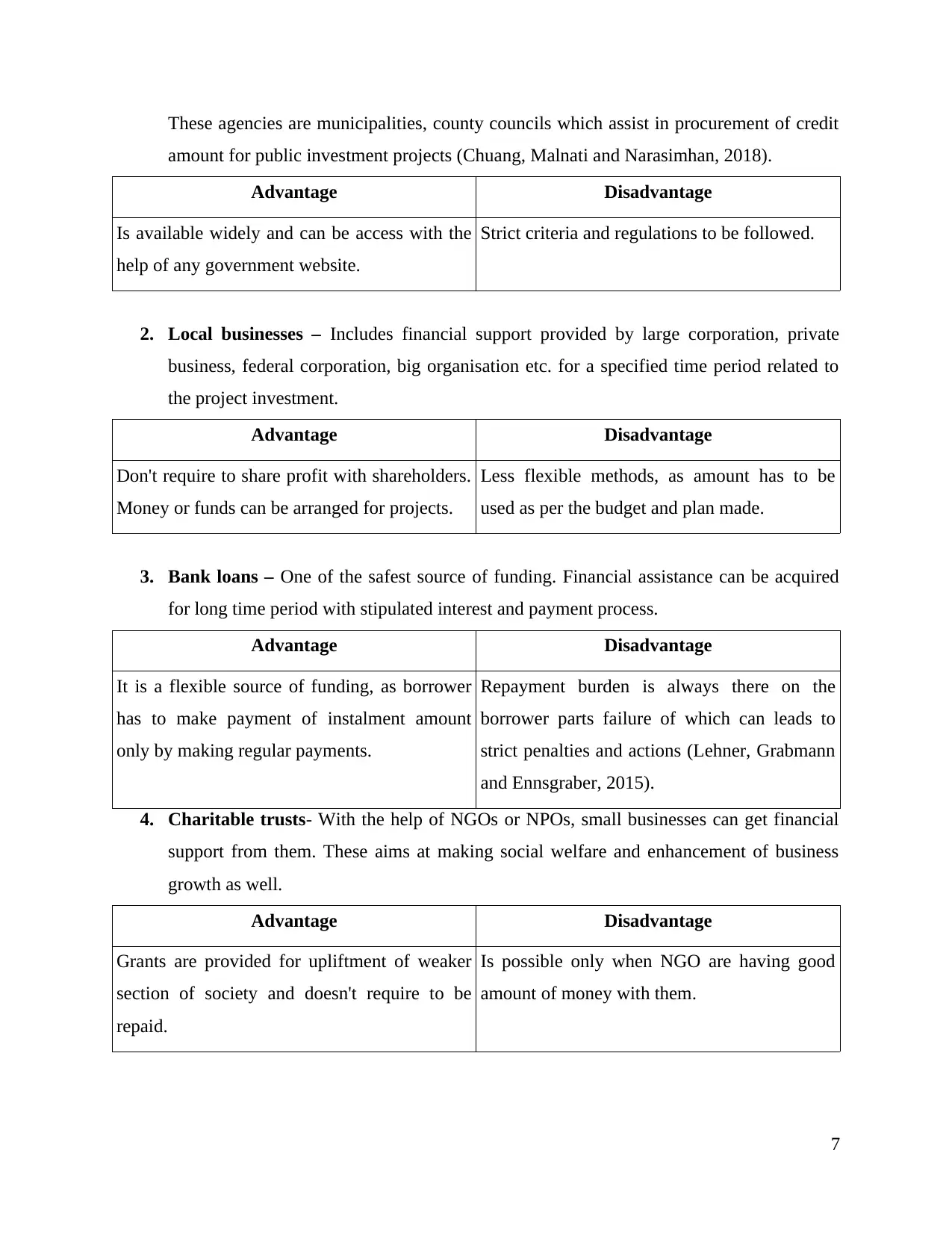
These agencies are municipalities, county councils which assist in procurement of credit
amount for public investment projects (Chuang, Malnati and Narasimhan, 2018).
Advantage Disadvantage
Is available widely and can be access with the
help of any government website.
Strict criteria and regulations to be followed.
2. Local businesses – Includes financial support provided by large corporation, private
business, federal corporation, big organisation etc. for a specified time period related to
the project investment.
Advantage Disadvantage
Don't require to share profit with shareholders.
Money or funds can be arranged for projects.
Less flexible methods, as amount has to be
used as per the budget and plan made.
3. Bank loans – One of the safest source of funding. Financial assistance can be acquired
for long time period with stipulated interest and payment process.
Advantage Disadvantage
It is a flexible source of funding, as borrower
has to make payment of instalment amount
only by making regular payments.
Repayment burden is always there on the
borrower parts failure of which can leads to
strict penalties and actions (Lehner, Grabmann
and Ennsgraber, 2015).
4. Charitable trusts- With the help of NGOs or NPOs, small businesses can get financial
support from them. These aims at making social welfare and enhancement of business
growth as well.
Advantage Disadvantage
Grants are provided for upliftment of weaker
section of society and doesn't require to be
repaid.
Is possible only when NGO are having good
amount of money with them.
7
amount for public investment projects (Chuang, Malnati and Narasimhan, 2018).
Advantage Disadvantage
Is available widely and can be access with the
help of any government website.
Strict criteria and regulations to be followed.
2. Local businesses – Includes financial support provided by large corporation, private
business, federal corporation, big organisation etc. for a specified time period related to
the project investment.
Advantage Disadvantage
Don't require to share profit with shareholders.
Money or funds can be arranged for projects.
Less flexible methods, as amount has to be
used as per the budget and plan made.
3. Bank loans – One of the safest source of funding. Financial assistance can be acquired
for long time period with stipulated interest and payment process.
Advantage Disadvantage
It is a flexible source of funding, as borrower
has to make payment of instalment amount
only by making regular payments.
Repayment burden is always there on the
borrower parts failure of which can leads to
strict penalties and actions (Lehner, Grabmann
and Ennsgraber, 2015).
4. Charitable trusts- With the help of NGOs or NPOs, small businesses can get financial
support from them. These aims at making social welfare and enhancement of business
growth as well.
Advantage Disadvantage
Grants are provided for upliftment of weaker
section of society and doesn't require to be
repaid.
Is possible only when NGO are having good
amount of money with them.
7
⊘ This is a preview!⊘
Do you want full access?
Subscribe today to unlock all pages.

Trusted by 1+ million students worldwide
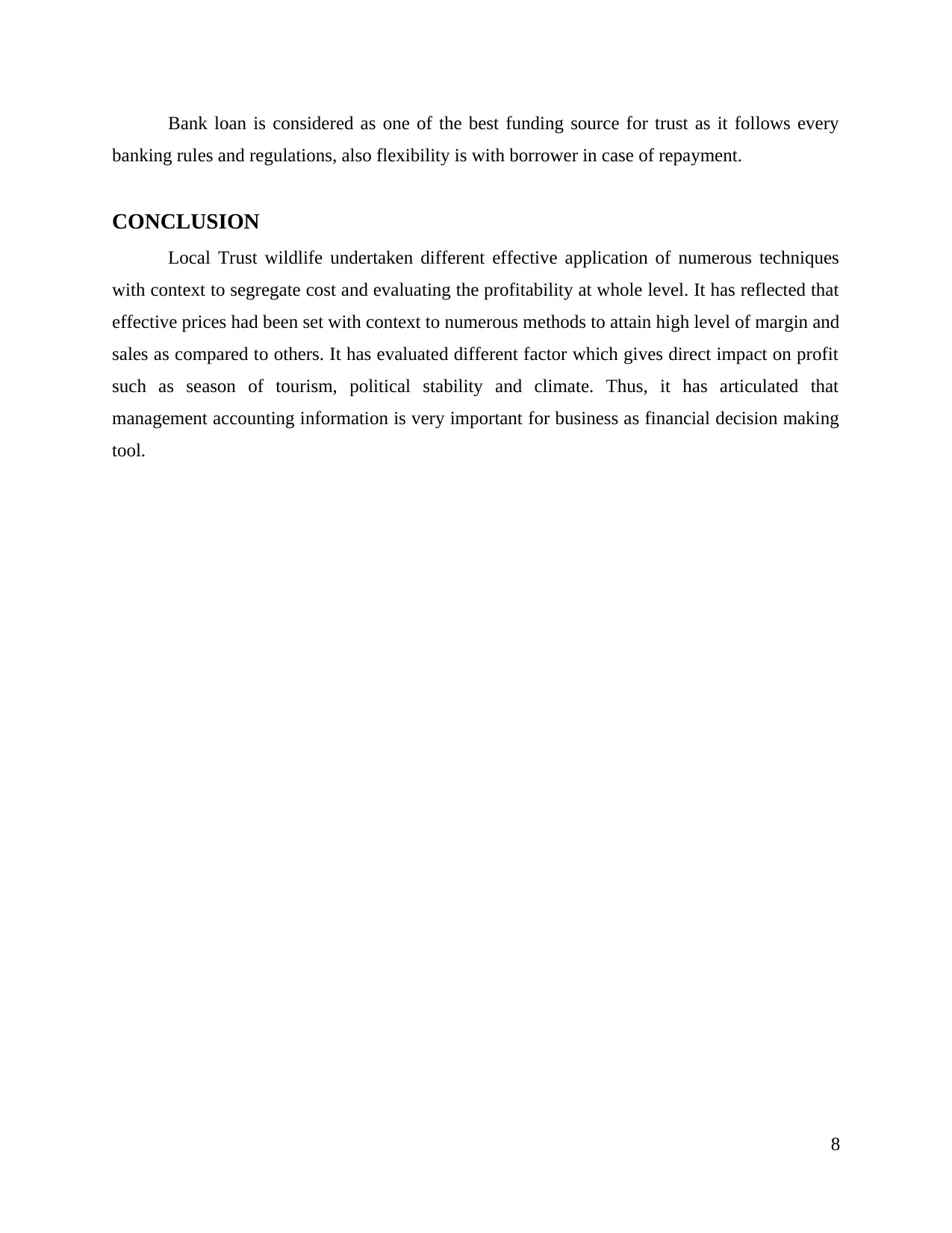
Bank loan is considered as one of the best funding source for trust as it follows every
banking rules and regulations, also flexibility is with borrower in case of repayment.
CONCLUSION
Local Trust wildlife undertaken different effective application of numerous techniques
with context to segregate cost and evaluating the profitability at whole level. It has reflected that
effective prices had been set with context to numerous methods to attain high level of margin and
sales as compared to others. It has evaluated different factor which gives direct impact on profit
such as season of tourism, political stability and climate. Thus, it has articulated that
management accounting information is very important for business as financial decision making
tool.
8
banking rules and regulations, also flexibility is with borrower in case of repayment.
CONCLUSION
Local Trust wildlife undertaken different effective application of numerous techniques
with context to segregate cost and evaluating the profitability at whole level. It has reflected that
effective prices had been set with context to numerous methods to attain high level of margin and
sales as compared to others. It has evaluated different factor which gives direct impact on profit
such as season of tourism, political stability and climate. Thus, it has articulated that
management accounting information is very important for business as financial decision making
tool.
8
Paraphrase This Document
Need a fresh take? Get an instant paraphrase of this document with our AI Paraphraser
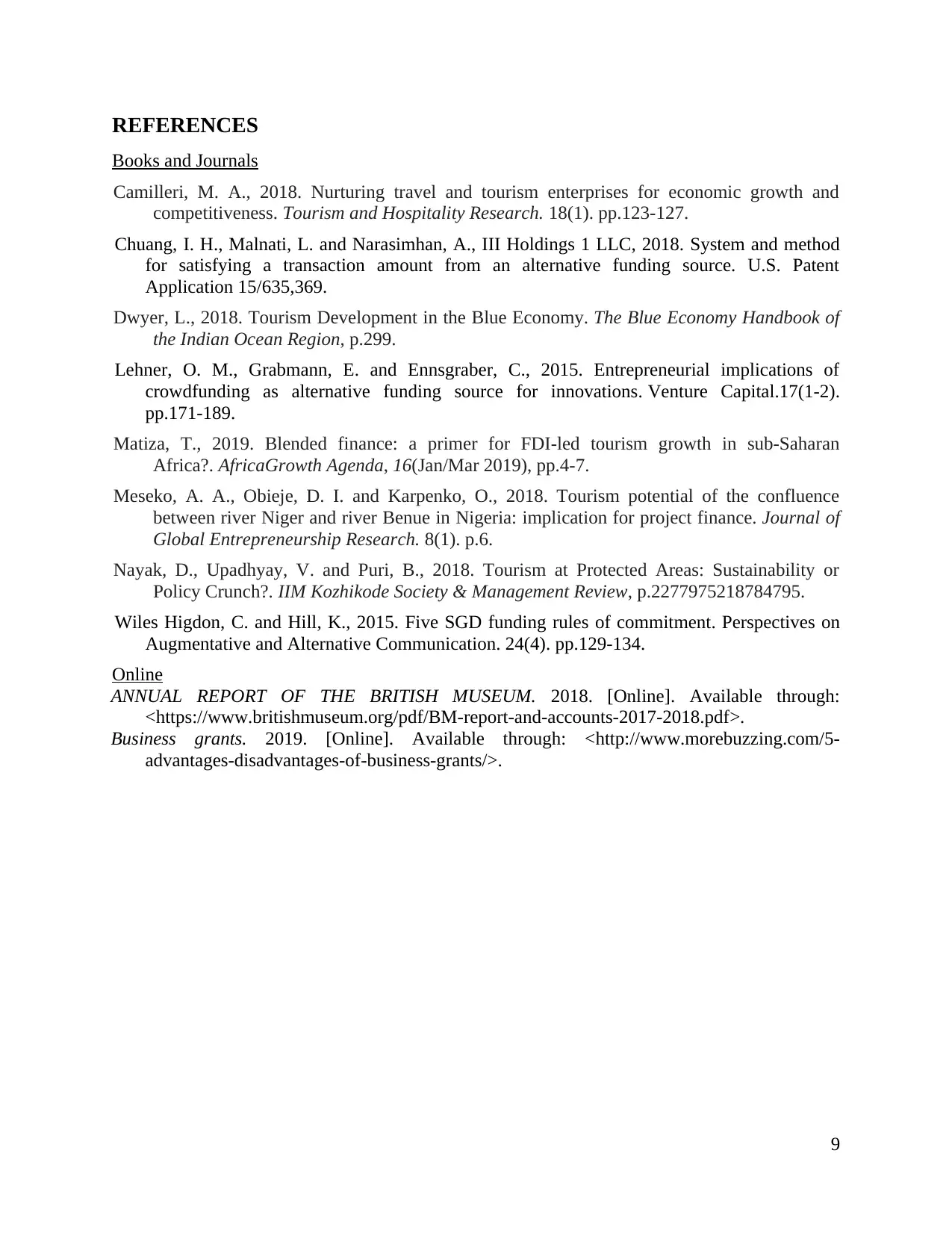
REFERENCES
Books and Journals
Camilleri, M. A., 2018. Nurturing travel and tourism enterprises for economic growth and
competitiveness. Tourism and Hospitality Research. 18(1). pp.123-127.
Chuang, I. H., Malnati, L. and Narasimhan, A., III Holdings 1 LLC, 2018. System and method
for satisfying a transaction amount from an alternative funding source. U.S. Patent
Application 15/635,369.
Dwyer, L., 2018. Tourism Development in the Blue Economy. The Blue Economy Handbook of
the Indian Ocean Region, p.299.
Lehner, O. M., Grabmann, E. and Ennsgraber, C., 2015. Entrepreneurial implications of
crowdfunding as alternative funding source for innovations. Venture Capital.17(1-2).
pp.171-189.
Matiza, T., 2019. Blended finance: a primer for FDI-led tourism growth in sub-Saharan
Africa?. AfricaGrowth Agenda, 16(Jan/Mar 2019), pp.4-7.
Meseko, A. A., Obieje, D. I. and Karpenko, O., 2018. Tourism potential of the confluence
between river Niger and river Benue in Nigeria: implication for project finance. Journal of
Global Entrepreneurship Research. 8(1). p.6.
Nayak, D., Upadhyay, V. and Puri, B., 2018. Tourism at Protected Areas: Sustainability or
Policy Crunch?. IIM Kozhikode Society & Management Review, p.2277975218784795.
Wiles Higdon, C. and Hill, K., 2015. Five SGD funding rules of commitment. Perspectives on
Augmentative and Alternative Communication. 24(4). pp.129-134.
Online
ANNUAL REPORT OF THE BRITISH MUSEUM. 2018. [Online]. Available through:
<https://www.britishmuseum.org/pdf/BM-report-and-accounts-2017-2018.pdf>.
Business grants. 2019. [Online]. Available through: <http://www.morebuzzing.com/5-
advantages-disadvantages-of-business-grants/>.
9
Books and Journals
Camilleri, M. A., 2018. Nurturing travel and tourism enterprises for economic growth and
competitiveness. Tourism and Hospitality Research. 18(1). pp.123-127.
Chuang, I. H., Malnati, L. and Narasimhan, A., III Holdings 1 LLC, 2018. System and method
for satisfying a transaction amount from an alternative funding source. U.S. Patent
Application 15/635,369.
Dwyer, L., 2018. Tourism Development in the Blue Economy. The Blue Economy Handbook of
the Indian Ocean Region, p.299.
Lehner, O. M., Grabmann, E. and Ennsgraber, C., 2015. Entrepreneurial implications of
crowdfunding as alternative funding source for innovations. Venture Capital.17(1-2).
pp.171-189.
Matiza, T., 2019. Blended finance: a primer for FDI-led tourism growth in sub-Saharan
Africa?. AfricaGrowth Agenda, 16(Jan/Mar 2019), pp.4-7.
Meseko, A. A., Obieje, D. I. and Karpenko, O., 2018. Tourism potential of the confluence
between river Niger and river Benue in Nigeria: implication for project finance. Journal of
Global Entrepreneurship Research. 8(1). p.6.
Nayak, D., Upadhyay, V. and Puri, B., 2018. Tourism at Protected Areas: Sustainability or
Policy Crunch?. IIM Kozhikode Society & Management Review, p.2277975218784795.
Wiles Higdon, C. and Hill, K., 2015. Five SGD funding rules of commitment. Perspectives on
Augmentative and Alternative Communication. 24(4). pp.129-134.
Online
ANNUAL REPORT OF THE BRITISH MUSEUM. 2018. [Online]. Available through:
<https://www.britishmuseum.org/pdf/BM-report-and-accounts-2017-2018.pdf>.
Business grants. 2019. [Online]. Available through: <http://www.morebuzzing.com/5-
advantages-disadvantages-of-business-grants/>.
9
1 out of 11
Related Documents
Your All-in-One AI-Powered Toolkit for Academic Success.
+13062052269
info@desklib.com
Available 24*7 on WhatsApp / Email
![[object Object]](/_next/static/media/star-bottom.7253800d.svg)
Unlock your academic potential
Copyright © 2020–2026 A2Z Services. All Rights Reserved. Developed and managed by ZUCOL.




